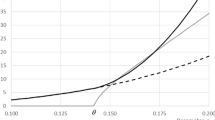Abstract
Acid deposition is a muitifaceted environmental phenomenon whose control represents one of the most controversial environmental policy areas. Because of the longrange transport of air pollutants contributing to acid deposition, its control is the responsibility of more than one region. Given the interdependence between the economic and environmental impacts of acid deposition as well as the interregional conflicts over its control, the present article proposes an interregional integrated economic-environmental model for the study of the impacts of acid deposition control policies. This model is solved with the use of a compromise programming procedure which facilitates the explicit treatment of conflicting regional goals. After the theoretical and operational forms and the solution procedure of the proposed model are described, the use of the model is illustrated with a simulation example using the 1963 MRIO accounts and hypothetical environmental data. The compromise programming procedure can form the basis for interactive decision processes when policy makers are exposed to the solutions yielded by the model. The model's usefulness and future research directions are discussed.
Similar content being viewed by others
Literature cited
Adams, R. C., and R. J. Moe. 1984. The impacts of acid deposition on regional economic activity. Pacific Northwest Laboratory, Richland, Washington.
Alcamo, J., L. Hordijk, J. Kamari, P. Kauppi, M. Posch, and E. Runca. 1985. Integrated analysis of acidification in Europe.Journal of Environmental Management 21:47–61.
Berkman, M., and P. Blair. 1985. Regional economic tradeoffs in sulfur emissions control policy.In F. J. Calzonetti and B. D. Solomon (eds.), Geographical dimensions of energy. D. Reidel, Dordrecht, The Netherlands.
Briassoulis, H. 1985. An integrated modeling approach to the study of impacts of acid deposition control regulations. PhD dissertation, University of Illinois, Urbana, Illinois.
Chen, C. W., S. A. Gherini, J. D. Dean, R. J. M. Hudson, and R. A. Goldstein. 1984. Development and calibration of the Integrated Lake-Watershed Acidification Study model.In J. L. Schnoor (ed.), Modeling of total acid precipitation impacts. Butterworth, Stoneham, Massachusetts.
Department of Energy. 1981. Matrix methods to analyze long-range transport of air pollutants. DOE/EN-0127. Office of Environmental Assessments, Washington, DC.
Drablos, D., and A. Tollan (eds.). 1980. Ecological impact of acid precipitation.In Proceedings of an International Conference at Sandefjord, Oslo, Norway.
Environmental Protection Agency. 1977. Compilation of air pollutant emission factors. AP-42. Office of Air Quality Planning and Standards, Research Triangle Park, North Carolina.
Gilleland, D. S., and J. H. Swisher. 1985. Acid rain control; the costs of compliance. Southern Illinois University Press, Carbondale, Illinois.
Gschwandtner, G., K. C. Gschwandtner, and K. Eldridge. 1984. Historic emissions of sulfur and nitrogen oxides in the United States from 1900 to 1980, vol. 1. Industrial Environmental Research Laboratory, USEPA, Research Triangle Park, North Carolina.
Hafkamp, W. A. 1984. Economic-environmental modeling in a national-regional system. North-Holland, Amsterdam.
IERE. 1981. Effects of the sulfur dioxide and its derivatives upon health and ecology, vols. 1 and 2. Electric Power Research Institute, Palo Alto, California.
Interagency Task Force on Acid Precipitation. 1981. National Acid Precipitation Assessment Plan [draft]. Washington, DC.
Krug, E. C., and C. R. Frink. 1983. Acid rain on acid soil: a new perspective.Science 221:520–525.
Leontief, W. W., and D. Ford. 1972. Air pollution and the economic structure: empirical results of input-output computations.In A. Brody and A. P. Carter (eds.), Inputoutput techniques. North-Holland, Amsterdam.
Lucas, A. E., and D. W. Cowell. 1984. Regional assessment of sensitivity to acid deposition for Eastern Canada.In O. P. Bricker (ed.), Geological aspects of acid deposition. Butterworth, Stoneham, Massachusetts.
Mayerhofer, P. M., and others. 1981. ENAMAP-1A Longterm sulfur dioxide and sulfate air pollution model: refinement of transformation and deposition mechanisms. Final report. Environmental Sciences Research Laboratory, USEPA, Research Triangle Park, North Carolina.
McFee, W. W. 1980. Sensitivity of soil regions to acid precipitation. Environmental Research Laboratory, USEPA, Corvallis, Oregon.
Menz, F. C., and J. K. Mullen. 1984. Acidification impact on fisheries: substitution and the valuation of recreation resources, chap. 9.In T. D. Crocker (ed.), Economic perspectives on acidic deposition. Ann Arbor Science Press, Ann Arbor, Michigan.
National Research Council. 1983. Acid deposition: atmospheric processes in Eastern North America. National Academy Press, Washington, DC.
Nijkamp, P. 1980. Environmental policy analysis. John Wiley, New York.
OECD. 1983. Costs of coal production abatement. Organization for Economic Cooperation and Development, Paris.
Oosterhaven, J. 1981. Interregional input-output analysis and Dutch regional policy. Gower, Hampshire, UK.
OTA. 1984. Acid rain and transported air pollutants: implications for public policy. OTA-0-204. Office of Technology Assessment, Washington, DC.
Polenske, K. R. 1980. The US multiregional input-output accounts and model. Lexington Books, Lexington, Massachusetts.
Record, F. A., D. V. Bubenick, and R. J. Kindya. 1982. Acid rain information book. Noyes Data Corporation, Park Ridge, New Jersey.
Rose, A. Z. 1976. A dynamic interindustry model for the economic analysis of air pollution abatement: theory and applications. Regional Science Dissertation and Monograph Series, Cornell University, Ithaca, New York.
Streets, D. G., and others. 1983. A regional new-source bubble policy for sulfur dioxide emissions in the Eastern United States. ANL/EES-TM-239. Argonne National Laboratory, Argonne, IL.
Streets, D. G., D. A. Hanson, and L. D. Carter. 1984. Targeted strategies for control of acidic deposition.Journal of Air Pollution Control Association 34:1187–1197.
Streets, D. G., and others. 1985. Climatological variability: effects on strategies to reduce acidic deposition.Environmental Science and Technology 19:887–893.
Wright, R. F. 1984 Norwegian models for surface water chemistry: an overview.In C. M. Bhumralkar (ed.), Meteorological aspects of acid rain. Butterworth, Stoneham, Massachusetts.
Zeleny, M. 1982. Multiple criteria decision making. McGraw-Hill, New York.
Author information
Authors and Affiliations
Rights and permissions
About this article
Cite this article
Briassoulis, H. Compromise solutions to the acid deposition control problem: a theoretical model and some simulation results. Environmental Management 11, 271–278 (1987). https://doi.org/10.1007/BF01867206
Issue Date:
DOI: https://doi.org/10.1007/BF01867206




